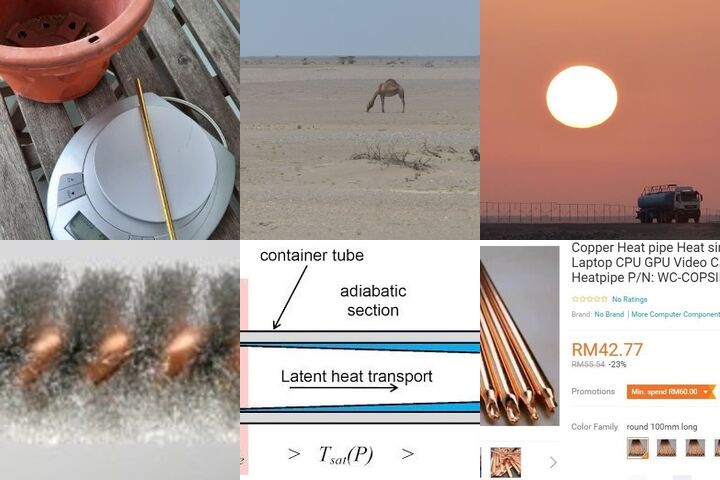Water for the desert
The Problem
There are many arid areas and deserts in the world where little grows. Climate change is expanding these dry areas and the IPCC is predicting that this trend will continue and intensify.
Our Proposal
In dry, arid, and desert conditions, there is a surprising amount of water carried in the hot air above the ground. Very occasionally this water settles out as dew on the ground surface. Our proposal uses heat pipes to better connect the large thermal buffer of the soil to the lower temperature air at night in the desert. Heat pipes work by transferring heat from one end to the other to reach the same temperature at both ends. We propose planting heat pipes vertically into the ground so that heat is drawn from the ground during the night increasing the depth of the cooler layer in the soil. The heat pipes encourage condensation of dew and provide a route by which the dew can be transferred into the soil, allowing plants to grow. This cycle repeats every night, gradually cooling the subsurface layer of the soil and building up a reserve of water.
We Assume that...
A small scale, plant-pot sized model can produce this proposed effect on an observable scale
The effect can be replicated by building fences of purpose-made heat pipes in lines across the desert to cool stripes of subsurface soil
That cooler subsurface soil will hold onto water better and make it more available for plants
Constraints to Overcome
Heat pipes are a simple and relatively low cost technology (1). They are closed pipes, containing a partial vacuum and a small amount of a liquid close to its boiling point under these conditions. This system allows heat to be transferred from one end to the other. Although this system is widely used in electronic devices and heat exchangers, there are no known cases of heat pipes being used to change the temperature gradient in the soil, in order to enhance the collection and retention of water. The constraint we propose to address is whether this effect can be observed in a real test, and what changes might be made to amplify the effect. (1)https://en.wikipedia.org/wiki/Heat_pipe
Current Work
The premise is that a passive heat pipe can be planted in soil and, over time, draw heat from below the surface so that the body of the soil becomes cooler and the water content increases. We would like to test this hypothesis with commercially-available heat pipes, soil, plant pots, kitchen scales, thermocouples, and close observation and repeated weighing over a period of months, using the following method. Several small heat pipes would be planted in a plastic flower pot, with three control groups: pots with empty copper pipes, wooden sticks, and with only soil. These pots, weighed and left outside in a covered area, would be weighed and the temperature would be measured several times a day. Each of the four groups would include multiple repeats. We would use the results of this experiment to inform our next steps.
Current Needs
Plant pots, soil, heat pipes, copper tubes, wooden sticks, thermocouples, data collector, and scales.
